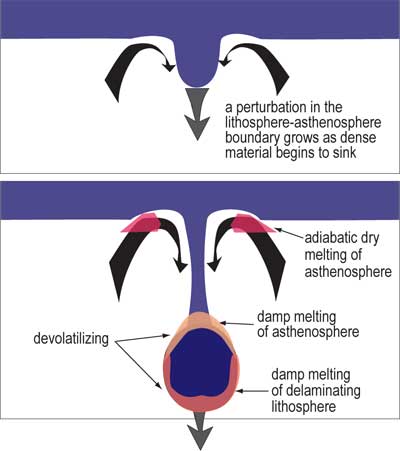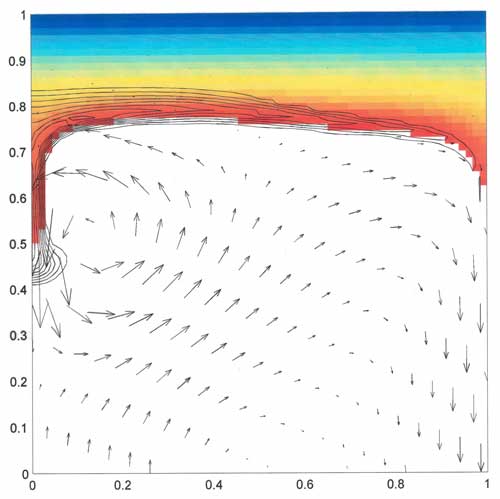 |
|
Continental
magmatism caused by lithospheric gravitational
instability
|
|
|
|
|
There are three fundamental ways
to cause the mantle to melt and produce magma:
-
bring the material closer to
the surface and allow it to melt through depressurization;
-
change the composition of the
material such that its melting point is lower; and
-
raise the temperature of the
material.
Process one,
melting through adiabatic decompression, is the main
process that operates at mid-ocean ridges. Beneath
ridges, there are upwelling zones in which melting
begins at about 50 km depth.
Process two,
changing the composition of the material, is the main
process that operates in subduction zones. Material
in the mantle wedge is brought to higher pressures
as it goes through the corner flow and begins to descend
with the slab, so there is only a small region in
which decompression can occur, before the corner of
the wedge is reached. In subduction zones, melt is
predominantly created by the addition of incompatible
chemical species that rise off the slab, mainly water,
sodium, and potassium. The addition of these oxides,
which do not fit into common mantle materials, acts
thermodynamically to reduce the temperature of melting
of the mantle, sometimes by as much as 100°C or
more (Hirschmann et al., 1999). In this situation,
mantle material can melt without changing its pressure
or temperature.
Process three,
raising the temperature of a piece of mantle material,
is a slow, low-volume process that can only operate
in specialized circumstances where very hot material
is brought into contact with colder material, and
the colder material heats up conductively. This is
an inefficient process that appears to have little
bearing on the production of major volumes of primary
volcanic magma on Earth.
|
Because depressurization
and the addition of volatiles are the major processes
that produce mantle melts on Earth, the production of
large-volume magmatism on continents is puzzling. In
general, continental lithosphere is thicker than oceanic
lithosphere, and so upwelling material beneath a continent
cannot depressurize to the same extent it can beneath
oceanic lithosphere: its ascent is blocked by the bottom
of the thick continental lithosphere (Figure 1). Researchers
who study mantle plumes under thick lithosphere find
that very high temperatures are required to allow an
upwelling plume to cross its solidus before it reaches
the bottom of the thick lithosphere and cannot rise
further. However, there is little petrologic evidence
for very high mantle temperatures. Kinzler &
Grove (1992) found that ambient mantle temperatures
between 1315°C and 1475°C can explain all geochemical
variation at mid-ocean ridges. Kojitano & Akaogi
(1997) found, based on calorimetric melting studies,
that MORBs erupting at 1200°C come from mantle at
1260°C, even lower than the temperature concluded
by Kinzler & Grove (1992).
Figure 1. Thermal model for melting
under continents. Approximate wet and dry solidii are
shown for both granite (a proxy for crust) and peridotite
(a proxy for both lower lithosphere and mantle). An
adiabatic geotherm is shown in the mantle, changing
to a conductive geotherm in the lithosphere. a) With
a mantle potential temperature of 1300°C no melt
is produced under the lithosphere. b) the lithosphere
has been thinned by half, and in both the upper mantle
and the lower crust ambient temperatures exceed the
solidii, creating melt. a) & b) demonstrate the
difficulty of producing mantle melt under thick lithosphere.
Click on images for enlargement.
Though some researchers have proposed
that the mantle is hotter beneath continents, there
is presently no compelling evidence for this. Mantle
with a potential temperature of 1475°C will melt
through decompression if it is raised to a depth of
about 115 km. Below 115 km, the hydrostatic pressure
of the mantle prevents melting. Thus we have the problem
of how to depressurize mantle beneath continents, where
the lithosphere is thought to be 150 – 250 km
thick. It should also be noted that numerical modeling
indicates that even very hot mantle plumes do not erode
the bottom of lithosphere (Moore et al., 1999),
and so cannot produce a longer melting column by removing
part of the lid. In addition to the problem of depressurizing
mantle beneath continents, there is no ready source
there of volatiles that could be added to the mantle.
Other processes must therefore be sought to produce
continental magmatism in the absence of subduction. |
The removal of the lower lithosphere
by gravitational instability, is a process that can
produce melt under continents. By removing the lower
lithosphere, mantle can rise higher and depressurize
more, producing more melt. Why, though, would the
lower lithosphere delaminate? There are two conditions
that must be met before instability can occur:
-
the lower lithosphere
has to be unstable gravitationally: that is, it
has to be denser than the material underlying it,
and thus be inclined to sink. The lower lithosphere
can be denser because of an intrinsic compositional
difference, such as having buoyant mantle residuum
beneath it, or it can become denser through cooling,
or by consisting of denser minerals;
-
viscosity must be
lowered. For lithosphere to detach and begin to
flow downward under the influence of gravity, its
viscosity must be low enough to allow flow. Though
some researchers have suggested brittle delamination,
there is little understanding of that proposed process
( Bird, 1979; 1988; Ed: Click here
for a webpage explaining these mechanisms). Here,
the assumed process of lithosphere thninng is Rayleigh-Taylor
instability: fluid flow under the influence of a
density instability. The flowing material is still
completely solid, but it behaves according to the
rules of fluid dynamics on a geologic time scale.
The control of viscosity
on gravitational instability has been studied by a number
of researchers, for problems concerning both the Earth
and the Moon (e.g., Hess & Parmentier,
1995; Conrad & Molnar, 1997; Houseman
& Molnar, 1997; Morency et al., 2002;
Elkins-Tanton et al., 2002). In the simplest
case, following the results of Hess & Parmentier
(1995), if fluid density decreases linearly with depth
(a density inversion is required for a Rayleigh-Taylor
instability to form) and the viscosities of all the
materials are equal and constant, the time scale for
a Rayleigh-Taylor instability to form can be expressed
as:

The initiation of an instability is accelerated by lower
viscosity and by a thicker unstable layer. While d
is the height of the instability, the width of the instability
can be given as:
 .
.
In the case of gravitational instability
of continental lithosphere over hot mantle, the viscosities
of the two materials will be different. In this case
the time for onset of an instability can be given as:

(Hess & Parmentier, 1995; Whitehead,
1988). Though the viscosity of the mantle contributes
more to the time of instability than the viscosity of
the lower lithosphere does, the difference in their
viscosities may be as much as six orders of magnitude,
and so a stiff lower lithosphere significantly inhibits
the formation of an instability.
|
In our research,
we find that the viscosity of the lower lithosphere
is the limiting factor in gravitational instability.
One simple scenario for gravitational instability occurred
in the Sierra Nevada about 3 million years ago, when
we think the thick root of the Sierra Nevada batholith
delaminated, causing a pulse of high-potassium magmatism
(Elkins-Tanton & Grove, 2003). A plate
had been subducting beneath the Sierras for tens of
millions of years, injecting subduction fluids and hot
silicate melts into the lower lithosphere. This had
the dual effect of heating the lower lithosphere and
hydrating it, both of which lower its viscosity (Hirth
& Kohlstedt, 1996). These are ideal conditions
for gravitational instability, and in fact gravitational
instability is supported both by studies of mantle xenoliths
(e.g., Lee et al., 2001; Ducea
& Saleeby, 1998) and by seismic studies of
mantle structure under the Sierras (Jones &
Phinney, 1998).
A second case where continental lithospheric
gravitational instability may have played a part is
in the eruption of the Siberian flood basalts. Though
the standard model for the Siberian flood basalts is
the rise of a huge, superheated plume from the lower
mantle, some important geological evidence contradicts
the pure plume model (Czamanske et al., 1988;
see also Siberia page). In
the plume model, the plume head is highly buoyant because
of its heat, and when it reaches the bottom of the lithosphere
it lifts it up into a dome while it melts (Richards
et al., 1989). In Siberia, evidence of terrestrial
fossils combined with pillow basalts show that the surface
of Siberia was actually subsiding, keeping the eruptions
just beneath sea level, for the first kilometer of the
flood basalt stack. This prompted us to suggest a scenario
in which a weak plume rises beneath Siberia, melts only
a small amount, and injects melt into the lower lithosphere
(Elkins-Tanton & Hager, 2000). This melt
freezes as eclogite in the lower mantle, increasing
its density, and the latent heat of freezing heats the
lower lithosphere, lowering its viscosity and allowing
gravitational instability. When the lower lithosphere
delaminates, its traction pulls the lithosphere down
and creates topographic subsidence, consistent with
the geological evidence. Our more recent results, as
yet unpublished, show that at least part of the Siberian
flood basalt magmas originated from mantle melting at
about 100 km depth, requiring a lithosphere thinner
than this. It might have been expected that the Siberian
craton was thicker than 90 km because of its great age,
and so our results are consistent with gravitational
instability.
|
How does gravitational instability cause magmatism?
First, when the lower lithosphere delaminates,
the mantle is immediately sucked into the void,
and may melt adiabatically. The dome left in
the lithosphere has a horizontal temperature
gradient across its edges, from the hot asthenosphere
now inhabiting the center, to the cool adjacent
lithosphere that did not delaminate. Horizontal
temperature gradients drive convection, and
the dome is soon filled with an umbrella-shaped
convection cell, pulling hot material up from
depth. This material may also melt, since it
can now rise to higher levels where the pressure
is lower (Figure 2).
Figure 2. Schematic model
for loss of the lithosphere by a Rayleigh-Taylor
instability. As the instability falls, asthenosphere
is sucked into the resulting lithospheric dome,
and may melt adiabatically. A convection cell
forms in the lithospheric dome due to horizontal
temperature gradients, and may also cause adiabatic
melting. As the instability falls, if it is
hydrous, it may dewater, triggering melting
of the mantle or of itself.
|
 |
Second, the delaminating piece itself
may induce magmatism, by dewatering as it falls. This
is the subject of our current research. If the delaminating
piece is hydrous, then as it falls through the mantle
and heats conductively, the water will be forced out
of it, just as hydrous fluids rise from subducting slabs
as slabs move out of the stability regimes of various
low-pressure and low-temperature hydrous minerals. It
is easy to demonstrate that heating is fast and efficient
enough to dewater a falling instability. This hydrous
fluid can have two effects: it can enter the overlying
hot mantle and allow it to melt, or it can allow parts
of the delaminating material itself to melt (Figure
2). This provides a number of geochemically different
source regions that can produce melt. Numerical models
indicate that, over a range of lithospheric thicknesses
and mantle potential temperatures, these processes can
create a wide range of melt volumes, even up to the
size of a flood basalt province (Figure 3).

Figure 3: Numerical experimental
results for delaminating hot, heavy lower lithosphere
in the Siberian flood basalt province (see also Siberia
page). The image shows a cross-section from the
top of the crust down into the mantle. The left boundary
is an axis of symmetry, passing through the center of
the Rayleigh-Taylor instability. Length scales on the
vertical and horizontal axes are non-dimensionalized,
but the scaled model box represents 200 km in width
and height. Arrows represent the velocity vector field,
colors represent temperature, with white being the mantle
potential temperature of 1480°C. Solid contours
mark degree of melt infiltration into the lower lithosphere,
where it causes both a density instability and lower
viscosity. The falling instability is already heated
almost to ambient mantle temperatures, indicating the
likelihood of dewatering if hydrous phases are present.
Any process that causes a density instability
and lowers the viscosity in the lower lithosphere, including
subduction or the existence of any upwelling creating
melt beneath the lithosphere, thus can trigger gravitational
instability. Gravitational instability itself causes
three processes that may lead to mantle melting under
continental lithosphere:
- convection in the resulting lithospheric dome,
- hydrous fluids entering the asthenosphere from the
falling lithosphere, and
- melting of the falling piece of lithosphere.
These processes can operate on small
or large scales, controlled in part by the thickness
of the unstable layer in the lithosphere, and modeling
indicates that a wide range of mantle melt volumes can
be produced.
|
-
Bird P. (1979) Continental delamination
and the Colorado Plateau. J. Geophys. Res.,
84, 7561-7571.
-
Bird P. (1988) Formation of the
Rocky Mountains, western United States: A continuum
computer model. Science, 239,
1501-1507.
-
Conrad, C.P. and P. Molnar (1997)
The growth of Rayleigh-Taylor-type instabilities
in the lithosphere for various rheological and density
structures. Geophys. J. Int., 129,
95-112.
-
Czamanske, G.K., A.B. Gurevitch,
V. Fedorenko, and O. Simonov (1988) Demise of the
Siberian plume: Paleogeographic and paleotectonic
reconstruction from the prevolcanic and volcanic
record, North-central Siberia, Int. Geology
Rev., 40, 95-115.
- Czamanske, G.K. and V.A. Fedorenko, Siberia.html
-
Ducea M. and J. Saleeby (1998)
A case for delamination of the deep batholithic
crust beneath the Sierra Nevada, California, Int.
Geology Rev., 40, 78-93.
-
Elkins-Tanton L.T. and B.H. Hager
(2000) Melt intrusion as a trigger for lithospheric
foundering and the eruption of the Siberian flood
basalt, Geophys. Res. Lett., 27,
3937-3940.
-
Elkins-Tanton L.T., J. A. Van
Orman, B. H. Hager, and T. L. Grove (2002) Reexamination
of the lunar magma ocean cumulate overturn hypothesis:
Melting or mixing is required, Earth Planet.
Sci. Lett., 196, 249-259.
-
Elkins-Tanton L.T. and T.L. Grove
(2003) Evidence for deep melting of hydrous, metasomatized
mantle: Pliocene high potassium magmas from the
Sierra Nevadas, J. Geophys. Res., 108,
2350, DOI 10.1029/2002JB002168.
-
Hess P.C. and E.M. Parmentier
(1995) A model for the thermal and chemical evolution
of the moon’s interior: Implications for the
onset of mare volcanism. Earth Planet. Sci.
Lett., 134, 501-514.
-
Hirschmannn, M.M., P.D. Asimow,
M.S. Ghiorso, and E.M. Stolper (1999) Calculation
of peridotite partial melting from thermodynamic
models of minerals and melts. III. Controls on isobaric
melt production and the effect of water on melt
production, J. Pet., 40,
831-851.
-
Hirth, G. and D.L. Kohlstedt
(1996) Water in the oceanic upper mantle: implications
for rheology, melt extraction and the evolution
of the lithosphere, Earth Planet. Sci. Lett.,
144, 93-108.
-
Houseman G.A. and P.A. Molnar
(1997) Gravitational (Rayleigh-Taylor) instability
of a layer with non-linear viscosity and convective
thinning of continental lithosphere. Geophys.
J. Int., 128, 125-150.
-
Jones C.H. and R.A. Phinney (1998)
Seismic structure of the lithosphere from teleseismic
converted arrivals observed at small arrays in the
southern Sierra Nevada and vicinity, California.
J. Geophys. Res., 103,
10,065 - 10,090.
-
Kinzler R.J. and T.L. Grove (1992)
Primary magmas of mid-ocean ridge basalts 2. Applications.
J. Geophys. Res., 97,
6907 - 6926.
-
Kojiaki H. and M. Akoagi (1997)
Melting enthalpies of mantle peridotite; calorimetric
determinations in the system, CaO-MgO-Al2O3-SiO2
and application to magma generation. Earth Planet.
Sci. Lett., 153, 209 - 222.
-
Lee C.-T., R.L. Rudnick, and
G.H. Brimhall Jr. (2001) Deep lithospheric dynamics
beneath the Sierra Nevada during the Mesozoic and
Cenozoic as inferred from xenolith petrology. Geochem.
Geophys. Geosys., 2.
-
Moore, W.B, G.Schubert, and P.J.
Tackley (1999) The role of rheology in lithospheric
thinning by mantle plumes, Geophys. Res. Lett.,
26, 1073-1076.
-
Morency C., M.-P. Doin and C.
Dumoulin (2002) Convective destabilization of a
thickened continental lithosphere. Earth Planet.
Sci. Lett., 202, 303-320.
-
Richards, M.A., R.A. Duncan,
and V.E. Courtillot (1989) Flood basalts and hot-spot
tracks: Plume heads and tails, Science,
246, 103-107.
-
Whitehead J.A. (1988) Fluid models
of geological hotspots. Ann. Rev. Fluid Mech.,
20, 61-87.
last updated 22nd November,
2006 |
|
|
